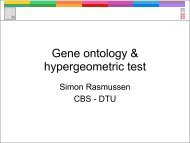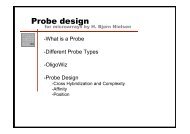Computational tools and Interoperability in Comparative ... - CBS
Computational tools and Interoperability in Comparative ... - CBS
Computational tools and Interoperability in Comparative ... - CBS
Create successful ePaper yourself
Turn your PDF publications into a flip-book with our unique Google optimized e-Paper software.
of the annotation. Some of the major contributors to<br />
the upstream peak <strong>in</strong> the start positions were different<br />
Streptococcus pyogenes stra<strong>in</strong>s, Bacillus genomes <strong>and</strong><br />
Yers<strong>in</strong>ia pestis genomes. These, <strong>in</strong> addition to<br />
Streptococcus agalactiae stra<strong>in</strong>s <strong>and</strong> Vibrio parahaemolyticus,<br />
were also prevalent <strong>in</strong> the stop position downstream<br />
peak. There was also a downstream peak <strong>in</strong> the<br />
start positions, <strong>and</strong> the genomes caus<strong>in</strong>g this peak were<br />
ma<strong>in</strong>ly Staphylococcus aureus, Bacillus cereus <strong>and</strong> several<br />
Escherichia coli relatives.<br />
Most of the start <strong>and</strong> stop deviations did not exceed<br />
100 nt. However, there were a few cases of deviations<br />
exceed<strong>in</strong>g 1000 nt, <strong>and</strong> these are not shown <strong>in</strong> the figure.<br />
This was the case for eukaryotic 23S <strong>and</strong> was ma<strong>in</strong>ly due<br />
to the three previously described stop positions predicted<br />
considerably downstream of the annotated stop position.<br />
In the two longer predictions from E. cuniculi, this was<br />
due to the HMM plac<strong>in</strong>g the latter 100 nt of the prediction<br />
further downstream to achieve a better score. Such <strong>in</strong>serts<br />
would most likely not appear when the spotter model is<br />
used first, s<strong>in</strong>ce the <strong>in</strong>serted sequence would be too long.<br />
To test this, a truncated version of the sequence was run<br />
through the predictor. The stop position was then<br />
accurately predicted. This phenomenon also expla<strong>in</strong>s<br />
some cases among the bacterial 16S predictions where the<br />
start position was placed very far upstream of the<br />
annotation. There were 27 rRNAs that had a start<br />
position predicted to start anywhere from 13 000 to<br />
40 000 nt upstream of the annotated start position. All<br />
but one of these were Firmicutes, mostly Streptococci <strong>and</strong><br />
Staphylococci. Closer study of the sequences revealed that<br />
the misplaced start position predictions were aga<strong>in</strong> due to<br />
long sequences be<strong>in</strong>g <strong>in</strong>serted near the start of the rRNA,<br />
<strong>in</strong>dicat<strong>in</strong>g that the first part of the HMM had been<br />
misplaced <strong>in</strong> the same manner as for Guillardia theta’s stop<br />
predictions. To test if these were the same k<strong>in</strong>d of <strong>in</strong>serts,<br />
a region end<strong>in</strong>g <strong>in</strong> the same place as the predictions but<br />
start<strong>in</strong>g 10 000 nt earlier was run through the full model<br />
predictor. This led to the bacterial 16S rRNAs be<strong>in</strong>g<br />
predicted with a deviation <strong>in</strong> start <strong>and</strong> stop positions on<br />
par with what was otherwise seen.<br />
Comparison to experimentally verified rRNAs<br />
Annotations were often ambiguous <strong>and</strong> considered<br />
unreliable. For discrepancies between annotations <strong>and</strong><br />
RNAmmer predictions, it is not a priori clear which of the<br />
two is correct. However, some genomes with experimentally<br />
verified rRNAs were selected to further assess the<br />
accuracy of start <strong>and</strong> stop predictions. The genomes<br />
we exam<strong>in</strong>ed were Anaplasma marg<strong>in</strong>ale Str. Maries,<br />
Chlamydia muridarum Nigg, Escherichia coli K12<br />
MG1655, Sulfolobus tokodaii Str. 7, Thermus thermophilus<br />
HB8 <strong>and</strong> Nitrobacter hamburgensis X14. These genomes<br />
all had complete 16S sequences accord<strong>in</strong>g to the NCBI<br />
database <strong>and</strong> had accompany<strong>in</strong>g literature which said that<br />
they were experimentally determ<strong>in</strong>ed. When check<strong>in</strong>g<br />
the positions of these rRNAs with BLAST aga<strong>in</strong>st the<br />
genome, some discrepancies were found. Due to this we<br />
used the BLAST results when compar<strong>in</strong>g annotated<br />
rRNAs to predictions.<br />
Nucleic Acids Research, 2007, Vol. 35, No. 9 3105<br />
In total, there were 14 copies of the six 16S sequences,<br />
<strong>and</strong> all of them were found by our predictions. Stop<br />
predictions were more accurate than start predictions.<br />
In all but four cases, the start position was predicted<br />
to be 7 nt downstream of the annotated start position.<br />
In A. marg<strong>in</strong>ale <strong>and</strong> S. tokodaii, the start position was<br />
predicted to be the same as annotation, <strong>and</strong> both of the<br />
two entries from C. muridarum were predicted to start 3 nt<br />
downstream of annotated start position. In N. hamburgensis<br />
the start position was, <strong>in</strong> contrast to the other cases,<br />
predicted to start 7 nt upstream of annotated start<br />
position. The stop positions <strong>in</strong> all but three predictions<br />
ended on the same position as the annotation. In N.<br />
hamburgensis predicted stop was 9 nt downstream,<br />
whereas <strong>in</strong> S. tokoaii <strong>and</strong> A. marg<strong>in</strong>ale the predicted<br />
stop was 1 nt downstream of annotation. Thus,<br />
all predictions were with<strong>in</strong> 10 nt of the annotated start<br />
<strong>and</strong> stop positions.<br />
Comparison to RFAM<br />
RFAM is a database of RNA families which <strong>in</strong>corporates<br />
secondary structure <strong>in</strong> its analyses. We have made a<br />
comparison with the 5S rRNA predictions of<br />
RFAM (17,18) for a selection of twenty prokaryotic<br />
genomes listed <strong>in</strong> Supplementary Table S5. There were a<br />
total of 55 5S annotated <strong>in</strong> these genomes. RNAmmer<br />
found 53 of them, while 54 were found <strong>in</strong> RFAM. In three<br />
of the genomes, both methods predicted a 5S to with<strong>in</strong> a<br />
few nucleotides of the annotated position, but both placed<br />
it on the other str<strong>and</strong>. Both predictors identified three new<br />
5S rRNAs with<strong>in</strong> these genomes, <strong>and</strong> at approximately the<br />
same positions. Two of these new 5S rRNAs followed<br />
another annotated 5S rRNA, look<strong>in</strong>g like a t<strong>and</strong>em<br />
repeat. In most cases, both methods placed the start<br />
position a few nucleotides downstream of the annotation,<br />
whereas the stop position was more evenly distributed<br />
around the annotated position. RNAmmer generally<br />
predicted rRNAs to be shorter by a nucleotide or two<br />
than RFAM, usually at start of the genes.<br />
Spotter pre-screen<strong>in</strong>g<br />
Table 3 shows that, with the exception of archaeal 5S,<br />
no full model hits were missed by the spotter model.<br />
Also, the spotter produced relatively few false positives,<br />
except for the eukaryotic 5S.<br />
M<strong>in</strong>imum, maximum, quantile <strong>and</strong> median scores for<br />
all the full model predictions are shown <strong>in</strong> Table 3, giv<strong>in</strong>g<br />
some <strong>in</strong>dication of the range of scores that rRNAs can be<br />
expected to have. The table also <strong>in</strong>cludes the threshold T99<br />
<strong>and</strong> the likelihood Pm<strong>in</strong> which <strong>in</strong>dicate that all full model<br />
predictions were expected to have correspond<strong>in</strong>g spotter<br />
model predictions except some among the archaeal 5S.<br />
Based on the relatively stable lengths of the different<br />
types of rRNAs <strong>and</strong> the correspond<strong>in</strong>g full model hits <strong>and</strong><br />
the position of the spotter hit with<strong>in</strong> them, we decided on<br />
w<strong>in</strong>dow sizes around spotter model hits to use when the<br />
spotter model is used first. These were chosen to be 300 nt<br />
for the 5S rRNA, 5000 nt for the 16/18S <strong>and</strong> 9000 nt for<br />
the 23/28S. Be<strong>in</strong>g roughly three times the length of the









